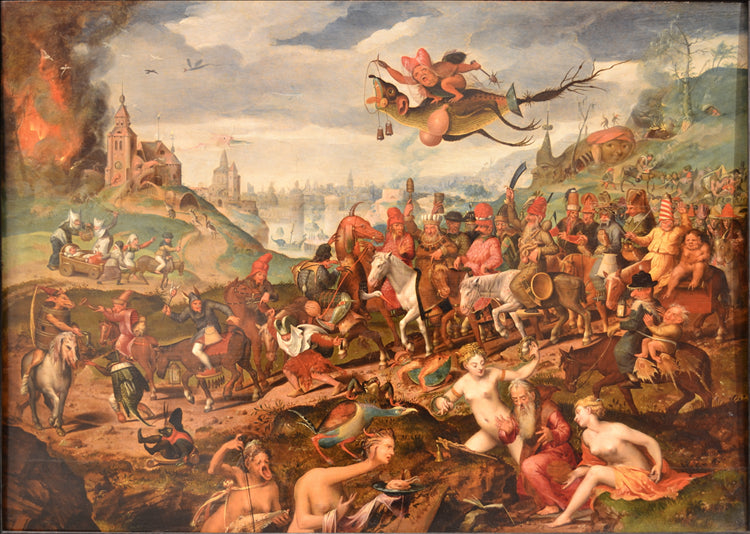Description
Pieter Brueghel the Younger's painting "The Temptation of Saint Anthony", painted around 1600, is a fascinating testament to Flemish art and the spiritual concerns of his time. As one of the works depicting the struggle between good and evil, the painting addresses a central theme in the life of Saint Anthony, a desert monk known for his demonic temptations. The title reveals not only the name of the saint, but also the sense of conflict that the canvas harbors.
From a compositional perspective, Brueghel the Younger achieves an intense narrative charge through the inclusion of a multitude of figures and elements. The viewer is quickly drawn into a world where the supernatural and the earthly co-exist. The central figure is Saint Anthony, who is shown surrounded by a series of grotesque demons and fantastic creatures that symbolize his temptations. Each figure in the painting presents physical distortions that emphasize their demonic nature, as well as their role in attempting to divert the saint from his spiritual path.
Colours play a crucial role in creating the atmosphere of the work. Dark and sombre tones predominate, contrasting with the bright and vivid colours used in the depictions of the demons and their traps. This use of colour not only establishes a sense of duality, but also contributes to the sense of chaos that envelops St Anthony as he faces his trials. The deep shadows and use of chiaroscuro add a three-dimensionality, making the characters seem to almost jump off the canvas.
One of the most remarkable aspects of “The Temptation of Saint Anthony” is the depiction of the saint’s suffering and his resistance to temptations. While he remains in a posture of contemplation and internal struggle, the tumult around him suggests the constant battle taking place not only in his mind, but in the human soul in general. This humanistic approach to religious history encapsulates a palpable and universal tension, where the viewer can identify with the saint in his struggle.
Furthermore, Brueghel the Younger's work is notable for its level of detail and the variety of characters. Each demonic figure seems to have its own story, which enriches the visual narrative. Attention to detail is a hallmark of the artist, inherited from his father, Pieter Brueghel the Elder, whose works also often addressed moral and religious themes, such as "The Fall of the Rebel Angels" and "Peasant Life." The paternal influence is felt in the complexity of this painting, where each element seems to contribute to a larger message about courage and resistance to sin.
It is also relevant to recognize that Brueghel the Younger was a prolific reproducer of his father's works, but also developed his own voice. His ability to capture vibrant and complex scenes, as seen in "The Temptation of Saint Anthony," reflects the transition from a Renaissance lifestyle to a more theatrical and dramatic approach in Baroque painting.
In conclusion, Pieter Brueghel the Younger's "The Temptation of Saint Anthony" is more than just a depiction of a religious episode; it is a profound exploration of human struggle, presented through a rich and elaborate composition. This work offers viewers a window into the human soul and its constant battles, using vibrant colors and memorable characters to convey a universal message that transcends time. In this canvas, one encounters not only art at its finest, but the intricate relationship between faith, desire, and resistance.
KUADROS ©, a famous painting on your wall.
Hand-made oil painting reproductions, with the quality of professional artists and the distinctive seal of KUADROS ©.
Painting reproduction service with satisfaction guarantee. If you are not completely satisfied with the replica of your painting, we will refund 100% of your money.

